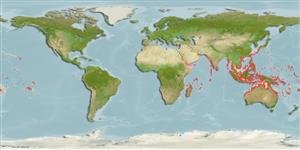Hexacorallia |
Scleractinia |
Agariciidae
Environment: milieu / climate zone / depth range / distribution range
Ecology
Reef-associated; depth range 0 - 40 m (Ref. 847). Tropical; 36°N - 29°S, 32°E - 137°W (Ref. 847)
Indo-Pacific.
Length at first maturity / Size / Weight / Age
Maturity: Lm ? range ? - ? cm
Small colonies are encrusting, and larger ones develop vertical plates that anastomose to form an interlocking matrix. The sides and edges of the plates are quite smooth. Individual corallites are tiny, superficial and run in irregular rows (Ref. 269).
Common in shallow to intermediate depths and may form colonies several meters in diameter and in height (Ref. 269). Common in shallow to intermediate depths (Ref. 269) in most reef habitats (Ref. 98471). Growth varies with water conditions: large, thin plates in clear shelter waters; thick plates in exposed areas; and minimal ridges form in high turbidity. The bivalve Barbatia helblingi was reported to be byssally attached, wedged between the plates of this coral (Ref. 130769).
Life cycle and mating behavior
Maturity | Reproduction | Spawning | Eggs | Fecundity | Larvae
Members of the class Anthozoa are either gonochoric or hermaphroditic. Mature gametes are shed into the coelenteron and spawned through the mouth. Life cycle: The zygote develops into a planktonic planula larva. Metamorphosis begins with early morphogenesis of tentacles, septa and pharynx before larval settlement on the aboral end.
Hodgson, G. 1998 Corals. p. 101-122. In Carpenter, K.E. and V.H. Niem (eds) FAO species identifidication guide for fishery purposes. The living marine resources of the Western Central Pacific. Vol. 1. Seaweeds, coral, bivalves and gastropods. FAO Rome. (Ref. 269)
IUCN Red List Status
(Ref. 130435: Version 2025-1)
CITES status (Ref. 108899)
Not Evaluated
Threat to humans
Human uses
| FishSource |
Tools
More information
Trophic EcologyFood items (preys)Diet compositionFood consumptionPredators Population dynamicsGrowth
Max. ages / sizes
Length-weight rel.
Length-length rel.
Length-frequencies
Mass conversion
Abundance
Life cycleReproductionMaturityFecunditySpawningEggsEgg developmentLarvae PhysiologyOxygen consumption
Human RelatedStamps, coins, misc.
Internet sources
Estimates based on models
Preferred temperature
(Ref.
115969): 24.7 - 29.1, mean 28 (based on 1136 cells).
Price category
Unknown.
